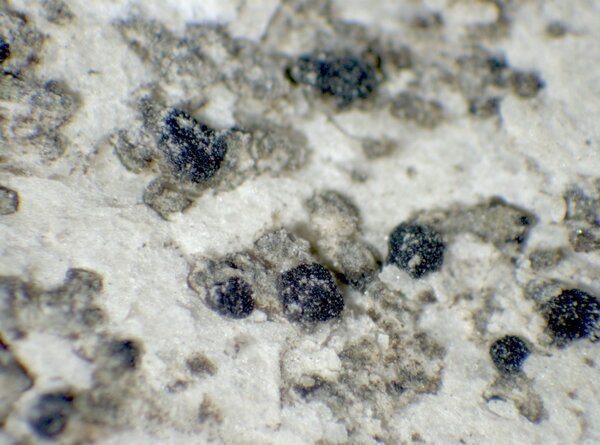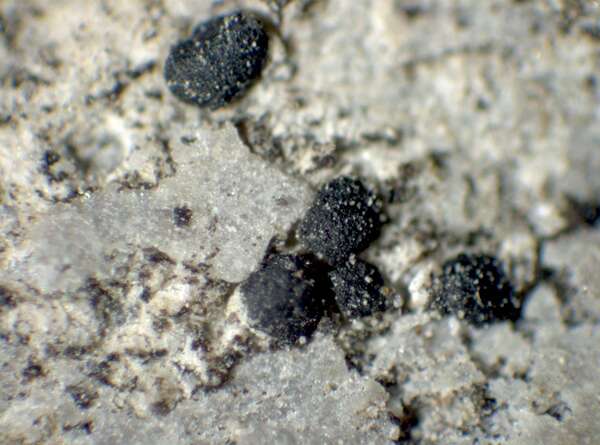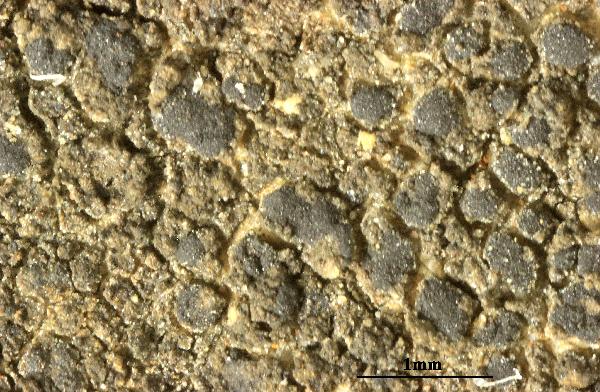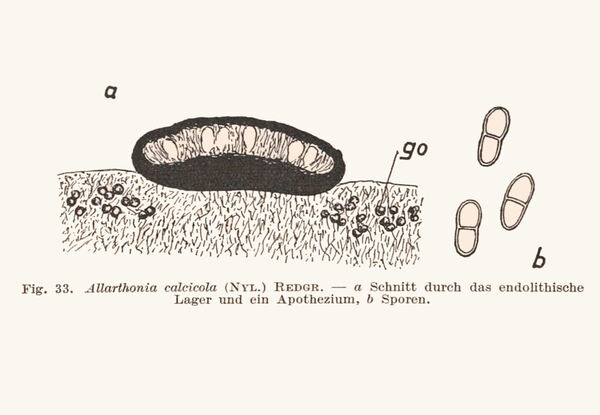Arthonia fusca (A. Massal.) Hepp
Flecht. Europ.: 534, 1860. Basionym: Catillaria fusca A. Massal. - Ric. Auton. Lich. Crost., 80, 1852.
Synonyms: Allarthonia fusca (A. Massal.) Sandst.; Allarthonia lapidicola auct. non (Taylor) Zahlbr.; Allarthonia lapidicola var. ruderella (Nyl.) B. de Lesd.?; Arthonia koerberi (J. Lahm) Malbr.; Arthonia lapidicola auct. non (Taylor) Branth & Rostr.; Arthonia ruderella Nyl.; Arthonia vagans Almq. var. koerberi (J. Lahm) Almq.; Catillaria ooliticola Walt. Watson; Coniangium fuscum (A. Massal.) A. Massal.; Coniangium rupestre Körb.
Distribution: N - Ven (Nimis 1994, Lazzarin 2000b), TAA (Nascimbene & al. 2022), Lomb, Piem (TSB 32906), Emil (Nimis & al. 1996, Fariselli & al. 2020), Lig. C - Tosc, Marc (Nimis & Tretiach 1999), Abr (Nimis & Tretiach 1999, Gheza & al. 2021), Mol (Nimis & Tretiach 2004, Caporale & al. 2008), Sar. S - Camp (Aprile & al. 2003b), Pugl (Nimis & Tretiach 1999), Bas (Nimis & Tretiach 1999), Cal (Puntillo 1996), Si (Caniglia & Grillo 2005, 2006).
Description: Thallus crustose, thin and mostly poorly evident, endosubstratic or thinly episubstratic and then continuous to scurfy, grey-brown. Apothecia arthonioid, emarginate, innate to adnate, angular or rounded, up to 0.5(-0.8) mm across, black, epruinose, flat to convex. Proper exciple poorly developed; epithecium reddish brown to brown-black, up to 15 μm high; hymenium colourless to greenish yellow in upper part, (35-)50-60 μm high, not inspersed with oil droplets, 1+ red, K/I+ blue; paraphysoids loose, (1-)1.5-2 μm thick, sparingly branched in upper part, the apical cells up to 3.5 μm wide, with a dark cap; hypothecium reddish brown to olive-brown. Asci 8-spored, broadly clavate to subglobose, semi-fissitunicate, with a large, non-amyloid apical dome, and a distinct ocular chamber, Arthonia-type. Ascospores 1-septate, constricted at septum, with subequal cells, hyaline, elongate-ovate to slightly sole-shaped, 11-18 x 4-7 μm. Pycnidia red-brown, immersed. Conidia bacilliform, 4-6 x c. 1 μm. Photobiont absent or species associated with green algae (perhaps lichenicolous, the algae being those of the host). Spot tests: K-, C-, KC-, P-. Chemistry: without lichen substances.Note: a holarctic species of calcareous rocks and mortar, most frequent on pebbles, but also on walls, roofing tiles etc.; in the eu-Mediterranean belt it is replaced by A. calcicola. According to Roux (in litt.) this species might not be lichenised, and grows on poorly developed crustose lichens. According to Cannon & al. (2020), the type of B. lapidicola has recently been found to represent a saxicolous morph of and an earlier name for Arthonia muscigena. The combination of A. lapidicola into Bryostigma made by Kondratyuk & al. (2020) was based on sequences identified as A. lapidicola by Frisch & al. (2014), but which are actually referable to A. fusca; according to Cannon & al. (2020), A. fusca belongs to the broad Bryostigma clade based on sequences of Frisch et al. (2014) labelled as A. lapidicola, but it may not be congeneric with Bryostigma s. str., and could be placed in its own genus along with A. apatetica which has similar paraphysoids .
Growth form: Crustose
Substrata: rocks
Photobiont: green algae other than Trentepohlia
Reproductive strategy: mainly sexual
Pioneer species
Commonnes-rarity: (info)
Alpine belt: very rare
Subalpine belt: rare
Oromediterranean belt: very rare
Montane belt: rather rare
Submediterranean belt: extremely rare
Padanian area: absent
Humid submediterranean belt: extremely rare
Humid mediterranean belt: absent
Dry mediterranean belt: absent

Predictive model
Herbarium samples


P.L. Nimis; Owner: Department of Life Sciences, University of Trieste
Herbarium: TSB (34784)
2002/02/01


P.L. Nimis; Owner: Department of Life Sciences, University of Trieste
Herbarium: TSB (34594)
2002/01/21


P.L. Nimis; Owner: Department of Life Sciences, University of Trieste
Herbarium: TSB (34594)
2002/01/21


Felix Schumm - CC BY 4.0
[VZ1077], Bohemoslovacia. Moravia. Distr. Brno, Vev. Bítýška, in
calcifodina prope pagum Lažánky, 380 m. Ad lapides schistoso-calcareos.
Leg. A. Vezda, 28.4.1972. EX A. VEZDA: LICHENES SELECTI
EXSICCATI NR. 1077.
Growth form: Crustose
Substrata: rocks
Photobiont: green algae other than Trentepohlia
Reproductive strategy: mainly sexual
Pioneer species
Commonnes-rarity: (info)
Alpine belt: very rare
Subalpine belt: rare
Oromediterranean belt: very rare
Montane belt: rather rare
Submediterranean belt: extremely rare
Padanian area: absent
Humid submediterranean belt: extremely rare
Humid mediterranean belt: absent
Dry mediterranean belt: absent

Predictive model
| Herbarium samples |


P.L. Nimis; Owner: Department of Life Sciences, University of Trieste
Herbarium: TSB (34784)
2002/02/01


P.L. Nimis; Owner: Department of Life Sciences, University of Trieste
Herbarium: TSB (34594)
2002/01/21


P.L. Nimis; Owner: Department of Life Sciences, University of Trieste
Herbarium: TSB (34594)
2002/01/21


 INDEX FUNGORUM
INDEX FUNGORUM
 GBIF
GBIF
 DOLICHENS
DOLICHENS



